
Social Motivators: The SCARF Model
At Steople we believe that leaders bring the weather, both sunshine and storms. In fact, a client I was recently coaching inadvertently brought the rain clouds to the office every time she walked in the room. Janet was an experienced manager, but new to her company. She came in eager to make a positive impression and quickly identified inefficiencies in her department. She created a plan, and to ensure that it was implemented according to her vision, she spent several hours sitting with each of her employees, showing them how to work more efficiently.
Status, Certainty, Autonomy, Relatedness, and Fairness are the characteristics that make up the SCARF model and when employees feel satisfied their needs are being met in each of these areas, dopamine is released and the part of the brain that recognizes rewards is activated. When employees find themselves in workplace situations that threaten their sense of security in these areas, they tend to retreat in an effort to find shelter from the storm.
Simply put, when we are in a mental state of security we tend to operate from the fontal cortex or the “thinking” part of our brain. When we are threatened, our reactions are dictated by the limbic system where our flight, fight, or freeze tendencies take over.
Janet and I talked about the SCARF model in relationship to her department, her employees, and her behavior. Janet took some time for self-reflection and considered which of the motivators were most important to her and how they might be different for her employees. She also had to step back and consider how her behavior might have threatened the psychological safety of her employees.
- Status – Janet decided that while it wasn’t her intention, her actions did not empower her team and could have threatened people’s need to be seen as valuable contributors. Epidemiologist Michael Marmot’s research suggests that “status is the most significant determinant of human longevity and health, even when controlling for education and income.” Long story short- everyone wants to feel important and by sweeping in and “solving” the problems without consulting others, several of the team members felt unimportant, devalued, and a diminished sense of self.
- Certainty – If the last few years have taught us anything, it is that the work environment is inherently volatile, complex, and full of ambiguity. Janet questioned how the immediate changes she implemented could have affected the security and stability team members felt over their own futures on the team and in the environment.
- Autonomy –Again, Janet’s intention was good, but when she stepped back from the situation, she questioned whether some people might have felt micromanaged by her presence as she individually walked people through her vision of how the processes should work rather then getting their buy-in and trusting their technical competence.
- Relatedness –When we don’t know someone well enough to understand their motivations, our tendency as human beings is to assume negative intent. Janet asked herself, “Did I do enough in my individual interactions to build a sense of relatedness and rapport to ensure that people understand my intentions in facilitating rapid change?”
- Fairness – The perception that an event has been unfair, Rock writes, generates a strong response in the brain stirring hostility and undermining trust. According to his research, “People who perceive others as unfair don’t feel empathy for the pain of others.” What may feel fair to one person, may not feel fair to another person. Without asking Janet wasn’t sure, but she did begin to see how people could have perceived the changes, the timing, or the methods of implementation as unfair.
Using the SCARF model as a guide for self reflection, Janet was able to recognize and deliberately shape future interactions to provide a safe harbor in which her employees were able to relax, thrive, and do their best work.
If you are looking for opportunities to grow your leader’s skills or to create a psychologically safe work environment for your team, reach out. At Steople we equip your leaders to avoid stormy conditions and bring smooth-sailing weather.
